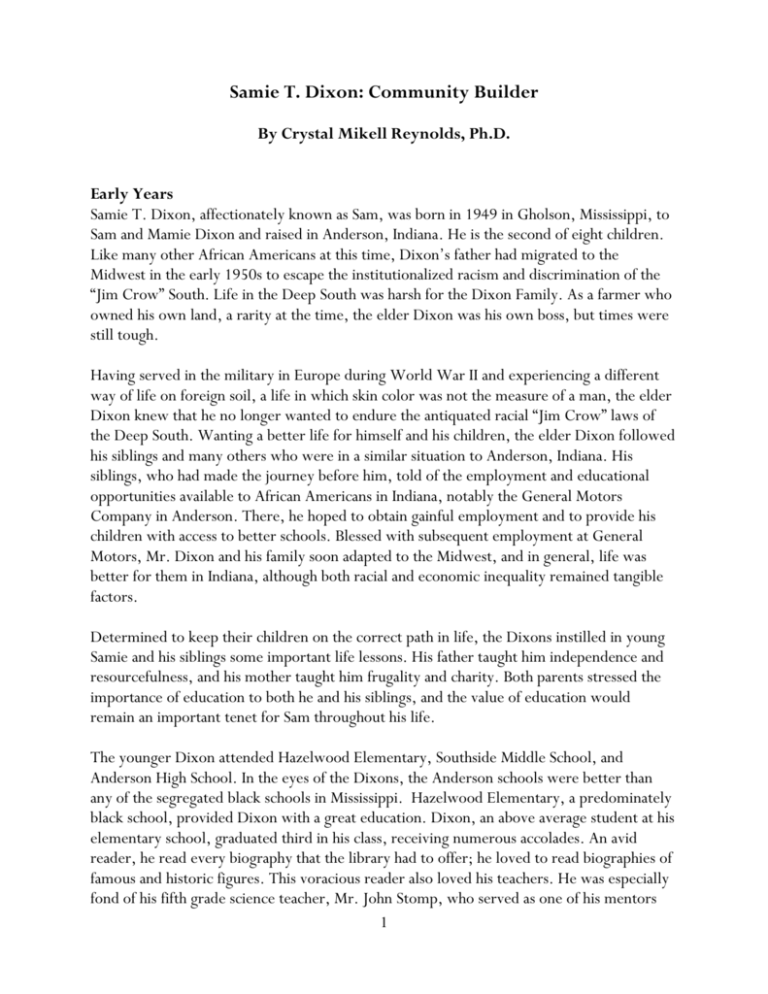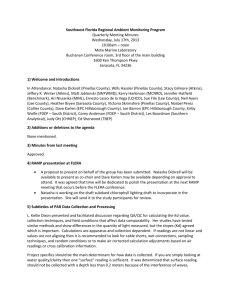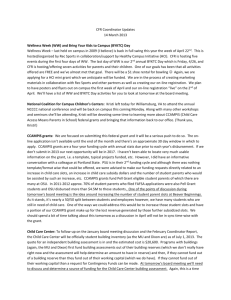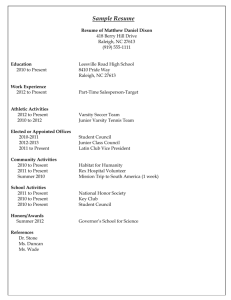Samie T. Dixon - Indiana State University
advertisement

Samie T. Dixon: Community Builder By Crystal Mikell Reynolds, Ph.D. Early Years Samie T. Dixon, affectionately known as Sam, was born in 1949 in Gholson, Mississippi, to Sam and Mamie Dixon and raised in Anderson, Indiana. He is the second of eight children. Like many other African Americans at this time, Dixon’s father had migrated to the Midwest in the early 1950s to escape the institutionalized racism and discrimination of the “Jim Crow” South. Life in the Deep South was harsh for the Dixon Family. As a farmer who owned his own land, a rarity at the time, the elder Dixon was his own boss, but times were still tough. Having served in the military in Europe during World War II and experiencing a different way of life on foreign soil, a life in which skin color was not the measure of a man, the elder Dixon knew that he no longer wanted to endure the antiquated racial “Jim Crow” laws of the Deep South. Wanting a better life for himself and his children, the elder Dixon followed his siblings and many others who were in a similar situation to Anderson, Indiana. His siblings, who had made the journey before him, told of the employment and educational opportunities available to African Americans in Indiana, notably the General Motors Company in Anderson. There, he hoped to obtain gainful employment and to provide his children with access to better schools. Blessed with subsequent employment at General Motors, Mr. Dixon and his family soon adapted to the Midwest, and in general, life was better for them in Indiana, although both racial and economic inequality remained tangible factors. Determined to keep their children on the correct path in life, the Dixons instilled in young Samie and his siblings some important life lessons. His father taught him independence and resourcefulness, and his mother taught him frugality and charity. Both parents stressed the importance of education to both he and his siblings, and the value of education would remain an important tenet for Sam throughout his life. The younger Dixon attended Hazelwood Elementary, Southside Middle School, and Anderson High School. In the eyes of the Dixons, the Anderson schools were better than any of the segregated black schools in Mississippi. Hazelwood Elementary, a predominately black school, provided Dixon with a great education. Dixon, an above average student at his elementary school, graduated third in his class, receiving numerous accolades. An avid reader, he read every biography that the library had to offer; he loved to read biographies of famous and historic figures. This voracious reader also loved his teachers. He was especially fond of his fifth grade science teacher, Mr. John Stomp, who served as one of his mentors 1 and role models. He instilled in his young mentee his philosophy that one should never settle for mediocrity, but rather one should always strive for excellence in all things, including the athletics that he so dearly loved. Throughout his life, he tried to live up to his mentor’s expectations of him. Although Dixon was no longer the star student, the favored son, as he had been in elementary school, he continued to do well in junior high, once again excelling in academics. It was in the early 1960’s while in junior high school that he first became aware of the injustices that surrounded him in his everyday life. This insightful teenager also became keenly aware of the injustices that were occurring nationwide. His awareness came as a result of a realization that African American students were being treated differently than their white counterparts at his school in the area of athletics. While in elementary school, he and his black classmates had been the city champions in basketball, but when he arrived at Anderson Junior High, he and his fellow black classmates were relegated to the practice squad. They were considered inferior players and did not merit having starting positions. However, according to Dixon, the young athletes were asked by some of their Andersen coaches to share their elementary school plays and techniques with them, the same plays and techniques that they had used to beat the same white kids who were now considered the superior athletes at the junior high. Although Dixon’s views and philosophy were not yet fully developed, he began to speak out about the disparate treatment in athletics that he witnessed at the school between him and his fellow black classmates and his white counterparts. For his efforts, he maintains that he was “blackballed” from participation in all three of the major sports at the school. Unfortunately, Dixon and his fellow black classmates would experience the same discrimination in high school athletics as they had experienced in junior high. But, at Anderson High School, this future Black Student Union leader, once again excelled both academically and socially. He soon began to be recognized as a student leader by his peers. As a student of the 1960s in the midst of a nationwide civil rights movement, this born leader began to take a primary role in the fight for justice and equality for his fellow black classmates. In his sophomore year at Anderson High School, he founded the Afro Students Association, an organization of black students that advanced the causes of black people. He, along with his fellow club members, fought for inclusion of all students in the school and its activities. He also made sure that the school’s library had copies of the popular black magazines as well as copies of books of the important black authors of the time. The conscientious Dixon wanted to ensure that positive images of black Americans were part of the fabric of the school. As a high school student, he along with several of his black classmates founded Sons and Sisters of Solidarity (SOS), an organization that worked toward equal treatment of members 2 of the black community in employment and in educational entities in Anderson. The members wanted to guarantee that people of color were in positions of authority. Additionally, the organization stressed the importance of the franchise, confirming that black people utilize the vote. Dixon knew the power of the vote and wanted an informed and active electorate in his hometown. While most sixteen and seventeen year olds were more concerned with the latest movie or song, this teenager was concerned about how to change his world. Dixon was heavily influenced at this time by the civil rights activist and Student Nonviolent Coordinating Committee (SNCC) leader Stokely Carmichael (Kwame Turé). Carmichael espoused the philosophy of Pan Africanism, that all black people were part of the African Diaspora and that they all shared a common history, tradition, and destiny. Carmichael’s views helped to shape Dixon who became a follower, an aficionado, of Carmichael in high school and throughout his college years, and read widely on the subject of Pan Africanism, attending numerous Carmichael lectures and workshops. It was also in high school that by luck, chance, or fate, Dixon attended a lecture where his science teacher Mr. Stomp used a phrase that would have a resounding effect on him; the succinct words would become his philosophy and shape and guide his life’s work. “It is better to be on the construction gang rather than on the wrecking crew,” so articulated the speaker. The speaker then went on to explain how he tries to help build up his world instead of destroying it. The teacher’s simple phrase proved very powerful to Dixon, and in essence explains his own life’s work, for he has spent much of his life trying to build his community up rather than trying to tear it down. After graduating from high school in the spring of 1968, this future educator enrolled at Indiana State University. Dixon chose Indiana State because he knew early on that he wanted to be an educator and was quite aware that this Indiana school was a leader in the field of education. He took his leadership experience, and his vision of a just and equitable society, and his new philosophy of being a builder to Indiana State. He did not abandon his work in Anderson however, for he would continue to work with both the Anderson based Afro Students Association and the Sons and Sisters of Solidarity throughout his tenure at ISU. Indiana State University Years Dixon soon adjusted to life at a predominately white campus. Settling into college life, he soon began to make friends and enjoy his college experiences. However, a storm was brewing on the horizon. His experiences in Anderson helped prepare him for the civil unrest and discontent that had been sweeping the country that would soon land at Indiana State University. The May 1, 1969, takeover of the administration building on ISU’s campus 3 would be his first tangible introduction to the black student discontent that had been brewing on the horizon at Indiana State. His direct role in the black student protest movement and his rise as a student leader would emerge in the spring of 1970 with the black student gymnasium takeover, the black power salute demonstration at the ISU men’s basketball game, the Blumberg Hall Incident, the Statesman Tower student race riots, and the formation of the Afro American Cultural Center and the Afro American Studies Program. (See Crystal Mikell Reynolds, Leadership Response to the Black student Protest Movement at Indiana State University 1998 doc.diss, for more information about these events). It is his role in the creation of the Afro American Cultural Center and the Afro American Studies Program where his leadership was most evident. Prime Minister Dixon was one of the driving forces behind the creation of the African and African American Studies program and the African American Cultural Center at Indiana State University. In October 1969, on the heels of the takeover of the administration building and in the midst of the rising storm of discontent among black students, Dixon became the new Prime Minister of the Black Student Union. In a July 2015 interview with the author, he maintained that the reason he was elected to that office was because he knew the issues and could speak about them with confidence and eloquence. Early on, his fellow brothers and sisters in the struggle were aware of his acumen. Following the May 1969 takeover of the administration building, he termed his first year in office as “Confrontation Year,” and in his words, “confront” meant to confront society and the university with the truth of the needs of the black students at ISU.” Before local and national television media, Dixon took a preemptive strike and outlined the major goals of the Black Student Union, all of which were aimed at making the University be true to its founding principles, including being open to the needs of all its students regardless of race or creed. This charismatic leader was acutely aware of the issues facing the black students on the campus at this time and the conditions of the black students at predominately white campuses. At Indiana State, the conditions would manifest themselves in the form of the lack of employment opportunities for black students, the lack of academic readiness of the black students compared to their white counterparts, the underrepresentation of black faculty and staff, the lack of knowledge and awareness of black culture by much of the black population, and the failure of the college to address the cultural needs of the black students. Dixon would be unaware of how prophetic his use of the word “confrontation” would be, for in April 1970, the storm that had been brewing on the horizon hit the campus sending shockwaves all over the state. Beginning with small skirmishes on campus between black and white female students throughout the day, the tensions would come to a climax that night as a race riot between approximately 100-200 black and 800-1000 white students occurred by 4 and in the Statesman Towers (razed August 2015) on Ninth Street. While there were many injuries and some property damage during this very surreal event, more damage to person and property was avoided due to an unseasonal thunderstorm that hit the Terre Haute area, which helped to disperse the crowds; the Indiana State Police in riot gear who teargassed the area; and the courageous efforts by Dixon and other Black Student Union members who repeatedly and adroitly drove cars into the mob and rescued black students. That weekend, Dixon, along with his fellow BSU members, honed the manifesto and black student demands that they had presented to President Alan Rankin the day of the riot. Credited with being the chief author of the ten demands, Dixon and his fellow black students, among other demands, called for a black studies program and a black cultural center. For the next two years, while serving first as BSU Prime Minister and then as a committee member, Dixon worked with then President Alan Rankin and other university stakeholders to address these two goals and further the causes of black students at ISU. With steady pressure and never settling for mediocrity as he had been instructed, Dixon, the BSU (with leaders such as Z. Mae Jimison, Joseph Arnold, and Horace Davis), and the local NAACP (Don Turner) were successful in persuading the university and President Rankin to address their demands for a black studies program and for an African American Cultural Center (now affectionately referred to as the Afro American Cultural Center). In recognition of his leadership, Dixon was named to the committee that would create the Afro American Studies Program, which began offering classes in fall 1972. Although he was a student member, his role on the committee proved vital to the founding of the department. Relinquishing the reigns of the BSU in 1971, he continued to work toward the realization of a place where black students could feel at home and a place that would celebrate what it means to be black in America. In October 1972, this dream became a reality under the acute eye of Prime Minister Z. Mae Jimison and Premier Joseph Arnold as the Center was officially dedicated. Dixon considers his roles in the development of the Afro American Studies Cultural Center and the Afro American Studies Program as his proudest achievements, for he held true to his basic tenet of building up the community rather than tearing it down. . Professional Achievements After graduating from Indiana State University in 1972 with a Bachelor of Science degree in Social Studies Education, Dixon moved to Chicago and worked at Malcolm X University in the Athletic Department as an instructor. Two years later, he attended Governor State University in Illinois where he earned hours toward a master’s degree in Afro American Cultural Studies. He then taught at Indiana University as an adjunct instructor in Labor Studies from 1986 to 1987. 5 In 1987, Dixon became Chief Bailiff for Judge Webster Brewer in Marion County Superior Court in Indianapolis for three years, and then he served for fifteen years as Chief Bailiff for Judge Z. Mae Jimison, the former BSU prime minister and a former Indiana State Distinguished Alumna. As Chief Bailiff, he was responsible for all operations of the Jimison Court, including being Intake Director of the Marion County Drug Treatment Diversion Program. While serving in his capacity as bailiff, he was a charter member and secretary of the Indiana Association of Drug Court Professionals. Whether in his role as an instructor or as a chief administrative officer, Dixon attempted to help as many individuals as he could, his goal was always to uplift. After his 15 year stint in one of the busiest courts in the country, he returned to his teaching roots. Since that time, he has taught social studies on both the middle school and high school level at schools in the Anderson area, including Southside Junior High, Northside Junior High, and Anderson High School. He presently teaches at Highland Junior High School in Anderson, Indiana, and also coaches 7th and 8th grade boys’ basketball. He enjoys imparting his love and knowledge of history to young minds. He tries to mentor his students, passing on those life lessons that his parents and teachers instilled in him. Honors, Awards, Community Involvement Sam Dixon presently serves on several Andersen community boards related to students, education, and the community at large, including Friends of Judge Webster L. Brewer Charitable Fund (fund which provides grants to youth in need); the Anderson Civilian Review Board (board which hears community complaints against governmental employees and officials); Anderson Impact Center (center which provides job training for young people); and Anderson Commission on the Social Status of African American Males (organization that mentors African American males for education and job training, especially former incarcerated males or those without employable work skills). While at Indiana State, he was president of the Black Student Union for two years, served on the university court of appeals, and on the committees that created the African and African American Studies (then Black Studies) program and the African American Cultural Center. He is the founder and president of The Incorporated Gathering, an ISU African American Alumni Association established in 1998, which serves African American graduates of ISU who graduated before 1976. Under his leadership of the Incorporated Gathering, the organization has grown to include over 400 African American alumni who return to the campus every two years for remembrance and celebration. The members of the organization mentor present day ISU students as well as provide donations to local non-profit organizations. 6 In addition to his work with the alumni organization, Dixon is an ordained minister and an associate pastor of Mount Pilgrim Church, Inc. in Anderson, Indiana, a title he has held since 1995. In this nondenominational Bible based church, Dixon and his fellow parishioners are able to demonstrate the philosophy of helping others and building up communities through their community service projects. All of Dixon’s community work and his values revolve around his adopted philosophy that it is better to build up rather than to tear down. One of Dixon’s most notable accomplishments to date is being one of the recipients of the 2015 Indiana State University Distinguished Alumni Award. The award is given annually to alumni who have distinguished themselves in a given field, someone who has made a significant contribution to the world around them. Conclusion From his humble beginnings to his leadership role on campus during a turbulent time in the nation’s history and through his public service, Dixon has strived to leave the world a better place. He helped guide the BSU and the university through the race riot of April 23, 1970 and through a tumultuous time on campus. As to why he held the leadership roles of the black organizations both on the high school and the college levels, this very thoughtful man believes that it was his destiny. This Distinguished Alumni Recipient maintains that he was destined to be a leader and to fight for the advancement of black people. He believes that this destiny lies in something spiritual, something greater than himself. He continues to serve on committees. Both in his professional role as an educator in the public schools and in his work on nonprofit organizations, he continues to fulfill his destiny as a leader who builds up rather than tears down. However, Dixon believes that despite all his efforts to help his fellow man and all those in the struggle, his greatest accomplishment is his family. He has been married for thirty years to his educator wife Mary, a 1974 and 1975 ISU graduate. They have seven children (Brian, Patrice, Safiya, Jamila, Makay, James, and Anika), fifteen grandchildren, and three great grandchildren. He has truly “built” a great family and a great legacy. 7 References: Mikell Reynolds, Crystal. Leadership Response to the Black student Protest Movement at Indiana State University 1998 (doc. diss.) Telephone and Personal Interviews with Sam T. Dixon: May 1997, August 2012, and July 2015. Crystal Mikell Reynolds, Ph.D.@2015 8






